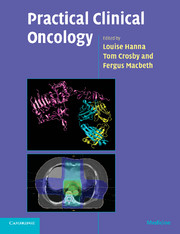Book contents
- Frontmatter
- Contents
- List of contributors
- Preface
- Acknowledgements
- Abbreviations
- 1 Practical issues in cytotoxic chemotherapy usage
- 2 Biological treatments in cancer
- 3 Hormones in cancer
- 4 Radiotherapy planning
- 5 Research in cancer
- 6 Oncological emergencies
- 7 Palliative care
- 8 Head and neck
- 9 Oesophagus
- 10 Stomach
- 11 Liver, gallbladder and biliary tract
- 12 Exocrine pancreas
- 13 Colon and rectum
- 14 Anus
- 15 Gastrointestinal stromal tumours
- 16 Breast
- 17 Kidney
- 18 Bladder
- 19 Prostate
- 20 Testis
- 21 Penis
- 22 Ovary
- 23 Body of the uterus
- 24 Cervix
- 25 Vagina
- 26 Vulva
- 27 Gestational trophoblast tumours
- 28 Lung
- 29 Mesothelioma
- 30 Soft tissue and bone tumours in adults
- 31 The lymphomas and myeloma
- 32 Central nervous system
- 33 Skin cancer other than melanoma
- 34 Melanoma
- 35 Thyroid
- 36 Neuroendocrine tumours
- 37 Cancer in children
- 38 Cancer of unknown primary
- 39 The use of radiotherapy in the treatment of benign conditions
- Multiple choice questions
- Multiple choice answers
- Index
- References
8 - Head and neck
Published online by Cambridge University Press: 23 December 2009
- Frontmatter
- Contents
- List of contributors
- Preface
- Acknowledgements
- Abbreviations
- 1 Practical issues in cytotoxic chemotherapy usage
- 2 Biological treatments in cancer
- 3 Hormones in cancer
- 4 Radiotherapy planning
- 5 Research in cancer
- 6 Oncological emergencies
- 7 Palliative care
- 8 Head and neck
- 9 Oesophagus
- 10 Stomach
- 11 Liver, gallbladder and biliary tract
- 12 Exocrine pancreas
- 13 Colon and rectum
- 14 Anus
- 15 Gastrointestinal stromal tumours
- 16 Breast
- 17 Kidney
- 18 Bladder
- 19 Prostate
- 20 Testis
- 21 Penis
- 22 Ovary
- 23 Body of the uterus
- 24 Cervix
- 25 Vagina
- 26 Vulva
- 27 Gestational trophoblast tumours
- 28 Lung
- 29 Mesothelioma
- 30 Soft tissue and bone tumours in adults
- 31 The lymphomas and myeloma
- 32 Central nervous system
- 33 Skin cancer other than melanoma
- 34 Melanoma
- 35 Thyroid
- 36 Neuroendocrine tumours
- 37 Cancer in children
- 38 Cancer of unknown primary
- 39 The use of radiotherapy in the treatment of benign conditions
- Multiple choice questions
- Multiple choice answers
- Index
- References
Summary
Introduction
It is not possible in a book with this format to discuss the treatment details for each tumour type, stage and subsite. This chapter highlights treatment principles and controversies.
This chapter covers the anatomical sites of the lip, oral cavity, pharynx, larynx, nose, paranasal sinuses, salivary glands, middle ear and squamous carcinoma of unknown primary. The first section considers general features of head and neck cancer. Subsequent sections focus on specific tumour sites.
General features of head and neck tumours
Types of head and neck tumour
The majority of head and neck cancers are squamous carcinomas, which account for 90% of all cases. The range of tumours is shown in Table 8.1.
Incidence and epidemiology of head and neck tumours
Approximately 8000 new cases occur per year in England and Wales (CRUK, 2004).
Approximately 3000 deaths occur per year in England and Wales (CRUK, 2004).
The UK annual incidence is approximately 14/100,000 cases per year (CRUK, 2004).
Regional variation in the UK is 8 per 100,000 in the Thames region compared to 13 to 15 per 100,000 in Wales and northwest England (NICE, 2004).
Head and neck tumours are more common in males than females (male-to-female ratio of 2:1), except for salivary gland tumours.
Incidence increases from middle age, with peak incidence occurring in the 60- to 75-age group.
Risk factors and aetiology for head and neck tumours
Prolonged exposure to environmental factors plays a key role.
- Type
- Chapter
- Information
- Practical Clinical Oncology , pp. 93 - 120Publisher: Cambridge University PressPrint publication year: 2008



